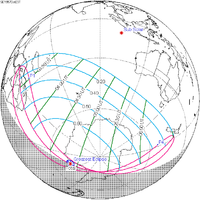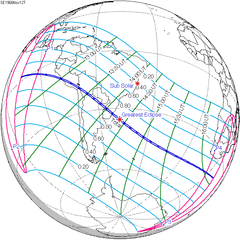| Total eclipse | |||||||||||||||||
 The Moon's hourly motion shown right to left The Moon's hourly motion shown right to left | |||||||||||||||||
| Date | November 7, 1957 | ||||||||||||||||
|---|---|---|---|---|---|---|---|---|---|---|---|---|---|---|---|---|---|
| Gamma | −0.4332 | ||||||||||||||||
| Magnitude | 1.0305 | ||||||||||||||||
| Saros cycle | 135 (20 of 71) | ||||||||||||||||
| Totality | 27 minutes, 57 seconds | ||||||||||||||||
| Partiality | 206 minutes, 32 seconds | ||||||||||||||||
| Penumbral | 349 minutes, 21 seconds | ||||||||||||||||
| |||||||||||||||||
| ← May 1957April 1958 → | |||||||||||||||||
A total lunar eclipse occurred at the Moon’s descending node of orbit on Thursday, November 7, 1957, with an umbral magnitude of 1.0305. A lunar eclipse occurs when the Moon moves into the Earth's shadow, causing the Moon to be darkened. A total lunar eclipse occurs when the Moon's near side entirely passes into the Earth's umbral shadow. Unlike a solar eclipse, which can only be viewed from a relatively small area of the world, a lunar eclipse may be viewed from anywhere on the night side of Earth. A total lunar eclipse can last up to nearly two hours, while a total solar eclipse lasts only a few minutes at any given place, because the Moon's shadow is smaller. Occurring about 5.1 days after apogee (on November 2, 1957, at 11:30 UTC), the Moon's apparent diameter was smaller.
This lunar eclipse was the last of an almost tetrad, with the others being on May 24, 1956 (partial); November 18, 1956 (total); and May 13, 1957 (total).
Visibility
The eclipse was completely visible over the eastern half of Asia, Australia, and Alaska, seen rising over the western half of Asia, Europe, and much of central and east Africa and setting over much of North America.
 
|
Eclipse details
Shown below is a table displaying details about this particular solar eclipse. It describes various parameters pertaining to this eclipse.
| Parameter | Value |
|---|---|
| Penumbral Magnitude | 2.09628 |
| Umbral Magnitude | 1.03050 |
| Gamma | −0.43321 |
| Sun Right Ascension | 14h49m49.6s |
| Sun Declination | -16°18'55.4" |
| Sun Semi-Diameter | 16'08.6" |
| Sun Equatorial Horizontal Parallax | 08.9" |
| Moon Right Ascension | 02h50m09.3s |
| Moon Declination | +15°55'18.7" |
| Moon Semi-Diameter | 15'08.8" |
| Moon Equatorial Horizontal Parallax | 0°55'35.5" |
| ΔT | 32.2 s |
Eclipse season
See also: Eclipse cycleThis eclipse is part of an eclipse season, a period, roughly every six months, when eclipses occur. Only two (or occasionally three) eclipse seasons occur each year, and each season lasts about 35 days and repeats just short of six months (173 days) later; thus two full eclipse seasons always occur each year. Either two or three eclipses happen each eclipse season. In the sequence below, each eclipse is separated by a fortnight.
| October 23 Ascending node (new moon) |
November 7 Descending node (full moon) |
|---|---|
 |

|
| Total solar eclipse Solar Saros 123 |
Total lunar eclipse Lunar Saros 135 |
Related eclipses
Eclipses in 1957
- An annular solar eclipse on April 30.
- A total lunar eclipse on May 13.
- A total solar eclipse on October 23.
- A total lunar eclipse on November 7.
Metonic
- Preceded by: Lunar eclipse of January 19, 1954
- Followed by: Lunar eclipse of August 26, 1961
Tzolkinex
- Preceded by: Lunar eclipse of September 26, 1950
- Followed by: Lunar eclipse of December 19, 1964
Half-Saros
- Preceded by: Solar eclipse of November 1, 1948
- Followed by: Solar eclipse of November 12, 1966
Tritos
- Preceded by: Lunar eclipse of December 8, 1946
- Followed by: Lunar eclipse of October 6, 1968
Lunar Saros 135
- Preceded by: Lunar eclipse of October 28, 1939
- Followed by: Lunar eclipse of November 18, 1975
Inex
- Preceded by: Lunar eclipse of November 27, 1928
- Followed by: Lunar eclipse of October 17, 1986
Triad
- Preceded by: Lunar eclipse of January 6, 1871
- Followed by: Lunar eclipse of September 7, 2044
Lunar eclipses of 1955–1958
This eclipse is a member of a semester series. An eclipse in a semester series of lunar eclipses repeats approximately every 177 days and 4 hours (a semester) at alternating nodes of the Moon's orbit.
The penumbral lunar eclipse on January 8, 1955 occurs in the previous lunar year eclipse set, and the penumbral lunar eclipse on April 4, 1958 occurs in the next lunar year eclipse set.
| Lunar eclipse series sets from 1955 to 1958 | ||||||||
|---|---|---|---|---|---|---|---|---|
| Ascending node | Descending node | |||||||
| Saros | Date Viewing |
Type Chart |
Gamma | Saros | Date Viewing |
Type Chart |
Gamma | |
| 110 | 1955 Jun 05
|
Penumbral
|
−1.2384 | 115 | 1955 Nov 29
|
Partial
|
0.9551 | |
| 120 | 1956 May 24
|
Partial
|
−0.4726 | 125 | 1956 Nov 18
|
Total
|
0.2917 | |
| 130 | 1957 May 13
|
Total
|
0.3046 | 135 | 1957 Nov 07
|
Total
|
−0.4332 | |
| 140 | 1958 May 03
|
Partial
|
1.0188 | 145 | 1958 Oct 27
|
Penumbral
|
−1.1571 | |
Saros 135
This eclipse is a part of Saros series 135, repeating every 18 years, 11 days, and containing 71 events. The series started with a penumbral lunar eclipse on April 13, 1615. It contains partial eclipses from July 20, 1777 through October 28, 1939; total eclipses from November 7, 1957 through July 6, 2354; and a second set of partial eclipses from July 16, 2372 through September 19, 2480. The series ends at member 71 as a penumbral eclipse on May 18, 2877.
The longest duration of totality will be produced by member 37 at 106 minutes, 13 seconds on May 12, 2264. All eclipses in this series occur at the Moon’s descending node of orbit.
| Greatest | First | |||
|---|---|---|---|---|
| The greatest eclipse of the series will occur on 2264 May 12, lasting 106 minutes, 13 seconds. | Penumbral | Partial | Total | Central |
| 1615 Apr 13 |
1777 Jul 20 |
1957 Nov 07
|
2174 Mar 18 | |
| Last | ||||
| Central | Total | Partial | Penumbral | |
| 2318 Jun 14 |
2354 Jul 06 |
2480 Sep 19 |
2877 May 18 | |
Eclipses are tabulated in three columns; every third eclipse in the same column is one exeligmos apart, so they all cast shadows over approximately the same parts of the Earth.
| Series members 12–33 occur between 1801 and 2200: | |||||
|---|---|---|---|---|---|
| 12 | 13 | 14 | |||
| 1813 Aug 12 | 1831 Aug 23 | 1849 Sep 02 | |||
| 15 | 16 | 17 | |||
| 1867 Sep 14 | 1885 Sep 24 | 1903 Oct 06 | |||

|

| ||||
| 18 | 19 | 20 | |||
| 1921 Oct 16 | 1939 Oct 28 | 1957 Nov 07 | |||

|

|

|

|

|

|
| 21 | 22 | 23 | |||
| 1975 Nov 18 | 1993 Nov 29 | 2011 Dec 10 | |||

|

|

|

|

|

|
| 24 | 25 | 26 | |||
| 2029 Dec 20 | 2048 Jan 01 | 2066 Jan 11 | |||

|

|

|

|

|

|
| 27 | 28 | 29 | |||
| 2084 Jan 22 | 2102 Feb 03 | 2120 Feb 14 | |||

|

|
||||
| 30 | 31 | 32 | |||
| 2138 Feb 24 | 2156 Mar 07 | 2174 Mar 18 | |||
| 33 | |||||
| 2192 Mar 28 | |||||
Half-Saros cycle
A lunar eclipse will be preceded and followed by solar eclipses by 9 years and 5.5 days (a half saros). This lunar eclipse is related to two total solar eclipses of Solar Saros 142.
| November 1, 1948 | November 12, 1966 |
|---|---|

|

|
See also
References
- "November 7–8, 1957 Total Lunar Eclipse (Blood Moon)". timeanddate. Retrieved 25 December 2024.
- "Moon Distances for London, United Kingdom, England". timeanddate. Retrieved 25 December 2024.
- "Total Lunar Eclipse of 1957 Nov 07" (PDF). NASA. Retrieved 25 December 2024.
- "Total Lunar Eclipse of 1957 Nov 07". EclipseWise.com. Retrieved 25 December 2024.
- van Gent, R.H. "Solar- and Lunar-Eclipse Predictions from Antiquity to the Present". A Catalogue of Eclipse Cycles. Utrecht University. Retrieved 6 October 2018.
- "NASA - Catalog of Lunar Eclipses of Saros 135". eclipse.gsfc.nasa.gov.
- Listing of Eclipses of series 135
- Mathematical Astronomy Morsels, Jean Meeus, p.110, Chapter 18, The half-saros
External links
- 1957 Nov 07 chart Eclipse Predictions by Fred Espenak, NASA/GSFC
This lunar eclipse-related article is a stub. You can help Misplaced Pages by expanding it. |


